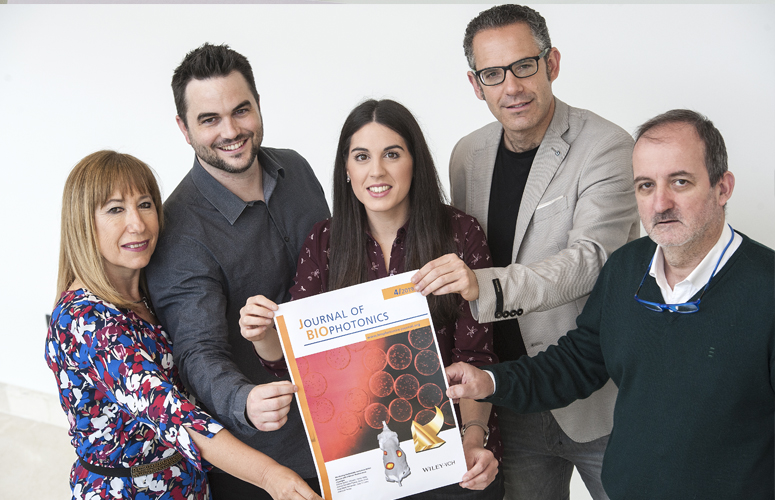Researchers at the UPV/EHU-University of the Basque Country have developed a biomedical device for cell immune-isolation (microcapsules) with an intrinsic capability so that it can be tracked once implanted in the organism. The work has been selected as the front cover of the April issue of the Journal of Biophotonics, one of the leading international journals in the field of photonic technology applications in biomedicine.
Biomedical devices are designed with natural fluorescence so that they can be monitored in the organism
- Research
First publication date: 02/05/2019

Researchers in the UPV/EHU’s NanoBioCel group together with the University of Michigan (USA) have developed a biomedical device for cell immune-isolation (microcapsules) with an intrinsic capability enabling it to be tracked once implanted in the organism. The innovative design has a built-in natural substance called genipin, which emits intense, stable fluorescence in the far-red range.
The non-invasive monitoring of biosystems based on implanted hydrogels generally requires indirect labelling of the vehicle or cargo, which increases the complexity and potential risk that its functionality may be altered. For the first time, this group of researchers has shown that hydrogel-based biosystems can be produced using biomaterials with intrinsic properties for the purpose of non-invasively monitoring them, in this case by using genipin.
“It is important to point out that until now nobody has exploited the natural fluorescence emitted by genipin as a non-invasive monitoring system in cell therapies implanted in living beings,” stressed the researchers. “As a first milestone in this respect we have developed an innovative immune-isolation device that has genipin built into its very design, which means it can be tracked once implanted in the organism. Through a fast, efficient, non-cytotoxic procedure we have managed to maximise the fluorescence of the microcapsules until an excellent signal to noise ratio has been achieved. We have also validated the use of genipin as a quantitative imaging probe by demonstrating that intense, stable fluorescence with good linearity of signal to dose of implanted microcapsule is obtained over several weeks. Through this strategy we have managed to immediately evaluate the actual dose injected and to monitor its position over time, which significantly improves the biosecurity and efficacy of the therapy."
The idea could also have a potentially successful application in the industry of nano-, micro- and macro-technologies based on hydrogels. These are destined to be essential components both for biomedical research and for advances in clinical medicine through applications, such as tissue engineering, regenerative medicine. “As these fluorescence imaging systems are gradually implemented in clinical practice, we believe that our proposal could be successfully applied in furthering a whole host of biotechnologies based on hydrogels, including the systems for delivering drugs and cells, vaccines or biosensors,” they concluded.
NanoBioCel is a research group attached to the UPV/EHU’s Pharmacy and Pharmaceutical Technology Laboratory and is also a member of CIBER-BBN (Networked Biomedical Research Centre for Bioengineering, Biomaterials and Nanomedicine) and of the unique scientific and technological infrastructure Nanbiosis-ICTS.
Bibliographic reference
- Monitoring implantable immunoisolation devices with intrinsic fluorescence of genipin
- Journal of Biophotonics (April 2019)
- DOI: 10.1002/jbio.201800170

